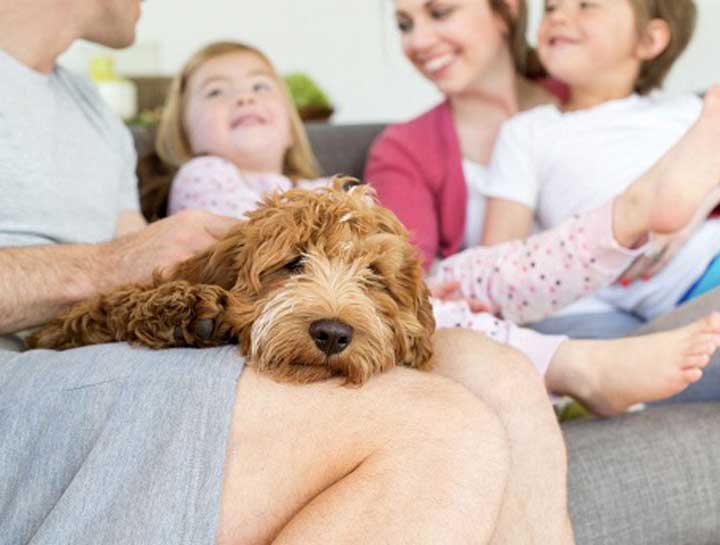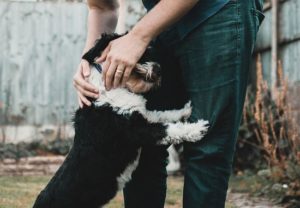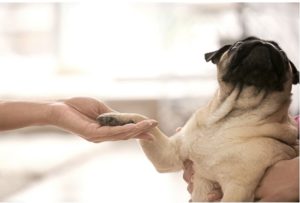To Keep or Rehome: The Plight of the COVID-19 Pandemic Dog

- The Perspective of Pandemic-Adopted Dogs
- How Rehoming Adopted Dogs Has Grown
- Keeping Your Dog—Tips for the Acclimation
- Rehoming Your Dog—Tips for the Transition
For better or worse, many people’s lives are vastly different than they were pre-pandemic. After adjusting to a “new normal,” including working from home, some employers want us to go back to our “old normal” and return to our office jobs. If you adopted a dog during COVID-19, it can be a difficult adjustment for everyone, and some find themselves considering if they can keep their new pet. Here are some things to consider…
The Perspective of Pandemic-Adopted Dogs
Imagine you’re a puppy or dog that was adopted during the COVID-19 pandemic. What fortune! Maybe you were adopted by a single person, or a nice young couple. Or maybe you had a family with children. The kids were homeschooled during the day while you laid at their feet or on their laps. During lunch, you and the kids went outside for recess!
Your owners worked from home and gave you all their attention. Lunchtime included a walk around the block. In the evenings, everyone would binge-watch the latest series on Netflix. Weekends were filled with trips to the park, trying out new recipes (you always got tossed a carrot or maybe a morsel of chicken!), or working on a house project. Life was great!

Then suddenly, everything changed (again). The kids went back to school, and Mom and Dad went back to the office. The family spends most, if not all, of their weekends with their other friends. And you?
Well, you’re at home. A LOT. Alone and lonely. Not to mention stressed. You’re anxious, you’re bored, and you just want something to do. Chewing shoes is fun (and there is still one left for tomorrow)! Until you get banished to the kitchen behind a baby gate. Chewing and digging at the baseboards keep you busy all day! But suddenly you get confined to a crate.
And now, the neighbors don’t appreciate the song you sing for your missing family. ALL. DAY. LONG. Now there’s talk of going home again, but this time it sounds a little different; “‘REhome?’ What does that mean?”
How Rehoming Adopted Dogs Has Grown
That is the plight of many dogs adopted during the COVID-19 pandemic. Fortunately, many dogs have adjusted well to “post-pandemic” life. They happily sleep away the day until their owners come home. But other dogs are having a harder time with the transition, and their owners feel like they have no choice but to find another home for their dog.
When the pandemic started, people who never had time for a dog suddenly found themselves with the opportunity of a lifetime: time to train a dog and interact with it each day. Shelters were empty and breeders with no experience jumped on the bandwagon to take advantage of the demand shortage.
Now, just the opposite is true; shelters are seeing an increase in intakes, Craigslist is filled with rehoming ads, and Facebook groups are littered with “Due to a change in work schedule, we must rehome our new dog” posts.

Many people hold the view that “my new dog was there for me in the worst of times, and I’ll be there for my dog now.” However, many others feel guilty about making their new dog stay home alone so much, and they believe that the best thing to do is find them a new home with someone who can dedicate the time they need.
How can you know what to do? Are there alternatives to rehoming a dog that you no longer have as much time for? Are there times when finding a new home is better for everyone?
Keeping Your Dog—Tips for the Acclimation
With planning, patience, and adjustments, someone can likely keep their dog, even with a major schedule change. (Our previous blog has some great tips on how to help your dog adjust when you must return to work, and how to recognize anxiety.)
Tweak your daily schedule
If your dog is having a hard time adapting, try waking up earlier in the morning to take your dog for a walk or jog. This can help expend excess energy that could be turned into destructive behavior or excessive vocalization after you leave for the day. It can also give you some extra time to bond with your best friend.
If your dog is having a hard time waiting for you to come home from work or school and is soiling in the house or crate, could you arrange to come home during lunch for a potty break, or have someone come and let the dog out?
Offer them some distraction
Leaving a TV or radio on when you leave the house can help pets to feel like they’re not all alone in an eerily quiet house. For some pets, toys or chews can be left in whichever area of the home that they are confined in while you’re away. A rotation of toys can help them stay mentally active and stave off boredom.

For other pets that are heavy chewers, toys or chews may not be enough, or even safe to leave without supervision as chews may become a choking hazard. To keep your home safe, a camera that lets you watch your pet from your phone can help reassure you that your dog isn’t up to no good. Some pet cameras even allow you to toss them a treat!
Give them play and exercise
In the evenings, another walk or some playtime will be in order, no matter how tired we are. For us, our dogs are just one part of our life. But for our dogs, we are their whole life and they have been waiting all day to see us.
Dogs need more than just physical exercise though; their minds need exercise too. Giving them dinner through a puzzle feeder or a snuffle mat can provide them with an engaging challenge. It can even provide you with time to prepare your meal or to have dinner in peace.
Take them out with you
Or, if you’re going to grab dinner out with friends, why not choose a dog-friendly restaurant and take your pooch with you? Most breweries are dog-friendly and offer food trucks—a great way to support two local businesses while spending time with two-legged and four-legged friends!
On weekends, try to choose activities that can include your dog. Going to the beach? Why not visit a dog beach? Picnic in the park or invite friends over instead of going out. Adjusting our activities to include our dog may take a little sacrifice, but the rewards for you both will be so worth it!

Get some outside help
If, despite your best efforts, your dog just cannot be left alone during the day, what can you do? Hiring a trainer can help identify any issues you may have missed and provide solutions to help your dog cope with separation anxiety. Speak with your vet, as anxiety medication can also help some dogs.
Daycare is a great solution for some dogs, providing them with a safe place to spend the day in the company of other dogs. Hiring a dog sitter can also be a good solution for some.
Many employers have found that working from home can be a positive consideration for some positions. So asking if you can work from home again, at least for a couple of days each week, is another option for some. It can lessen the stress your pet feels and reduce the amount of medication, daycare, or other alternative care needs.
Rehoming Your Dog—Tips for the Transition
Keeping your dog would be the ideal goal because no doubt rehoming a dog can have a traumatic effect on them. They are used to their routine, their people, their home, and the idiosyncrasies every family has.
On the other hand, the resiliency of dogs is part of why we love them. They can get used to a new routine, learn a new family and their habits, and even learn a new name. When would this be considered the best option? It depends on the circumstances.
Assess the reasons for rehoming
What if you have tried helping your dog adjust and they just aren’t able to cope? Maybe you keep getting warnings from your landlord or neighborhood association that your dog’s barking is a nuisance.

What if you truly are finding yourself leaving for work before sunrise and getting home with just enough time to grab a late-night snack and falling exhausted into bed—only to rinse and repeat the next day?
Or what if you are a victim of the pandemic too, and you’ve lost your job, you’re struggling, and you are genuinely unable to afford to keep your dog? “Wouldn’t a new home be better for the dog?” you may ask.
Consider the options for rehoming
In these situations, it may indeed be better for everyone to find your dog a new home. How can you set your dog up for success? First, do your research. If your dog came from a reputable breeder, then they will most likely take the dog back.
Some shelters have a short window that a dog must be adopted before they are euthanized, so be sure to choose a non-kill shelter. Or better yet, if your dog is a specific breed, a rescue group may be an option. A donation is certainly appreciated if a shelter or rescue group can help you.
Maybe friends or family can adopt your dog, or maybe one of the aforementioned Facebook groups—for your type of dog—can put you in touch with someone looking for a new family member.

Ensure your dog’s well-being
Whatever avenue you choose, be sure to be completely open and honest about your dog, its habits, and its temperament. If your dog doesn’t like children or men, for example, be sure to let the group know. This will help ensure your dog doesn’t get placed in a home for which they are unsuited—and increase the chances that they would need to be rehomed again.
The same transparency is needed for your dog’s level of potty training. Many people have been told their new dog is completely housebroken, only to find out that this is far from the case. If the new owner doesn’t have the time or patience required to train an older dog, then this, again, can increase the chances that the dog could be returned to the shelter.
Does your dog suffer from separation anxiety? Are they very vocal? Do they dislike cats or the company of other dogs? Let the family, shelter, or rescue group know. This doesn’t necessarily mean that they won’t take your dog, but the information will enable them to make the best match.
If you decide on a private placement (meaning, you find your dog its new home on your own), you might consider offering the adopters the prospect of taking back the dog to find it a new home, if they ever need to rehome it. This will help ensure that the dog doesn’t end up in a kill shelter later.

If allowed, send your dog to its new home with its crate, bed, toys, and the food they’ve been eating, along with its vet records. This will help them feel more comfortable and ease their transition—and your peace of mind.
It is hoped that with these ideas and a little creativity—and perhaps even some investment—you and your dog will continue to be best buddies, even with a schedule change. If not, we hope you feel like you’ve done your best and can help your dog smoothly adjust to its new home.
